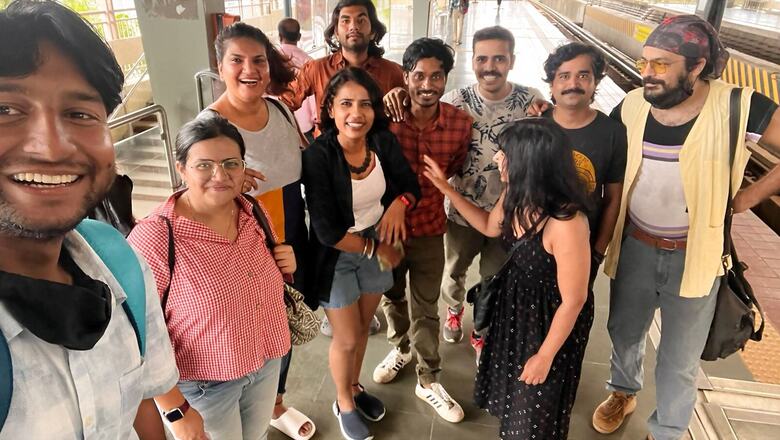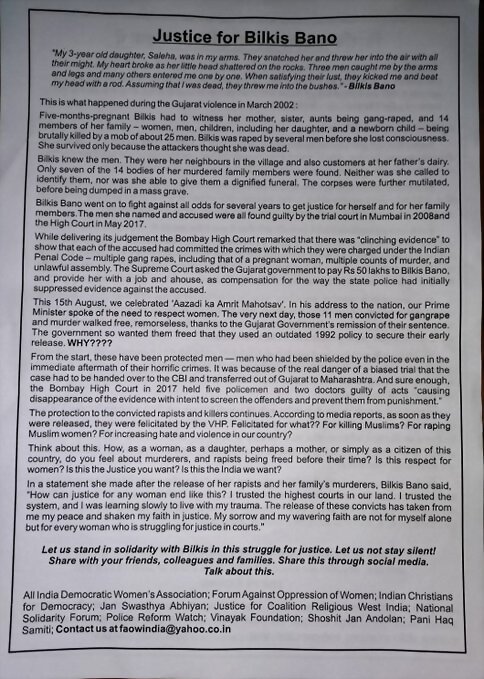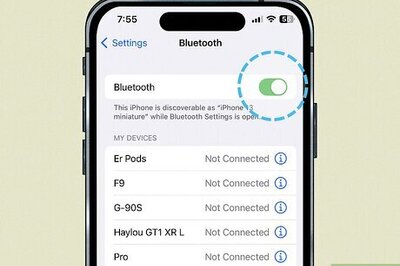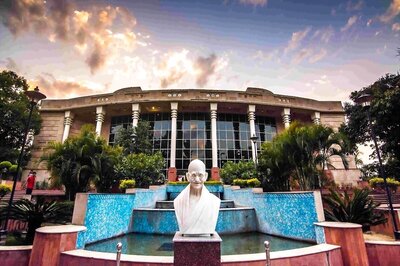
views
A week after Bilkis Bano’s rapists were released from prison under a remission policy, a group of women in Mumbai got into the ladies’ compartment of a local train from Churchgate to Borivali, armed with leaflets, speaking to commuters, explaining the case, and campaigning for justice.
It was a Monday afternoon and the women hopped into around eight or nine trains over a span of three hours, speaking to women and asking them to sign a “simple demand of standing with Bilkis for justice and demanding that the remission be cancelled”. By the time they finished, they had collected around 400 signatures.
Feminist and queer rights activist and researcher Chayanika Shah, who was part of the group, shared the experience on Twitter, writing, “We have done these actions in the past for different issues. Today was very different though.”
Today some 8 or 9 of us went in the women’s compartment of the local train from churchgate to borivali and back talking to commuters there about the remission given to the rapists and murderers of bilkis and her family members. We may have gone in 8 or 9 trains.— Chayanika (she/her) (@chayanikashah) August 22, 2022
Origin Story
Shah, who is a member of the Mumbai feminist group Forum Against Oppression of Women (FAOW), told News18 over phone that the local train had, in fact, been an integral part of the feminist movement and their campaigns in the 80s and 90s.
“We had identified the train as a very important part of our lives as working women in this city,” Shah said. “As a collective, the train has been one of our very important spaces for communication. The train in Bombay is actually what allows women to travel late at night and be independent… all of us, at different points, have used the train and the train station, as a point of contact, which works a lot in Bombay.”
Dr Vibhuti Patel, former head of department at SNDT University, and Women’s Studies professor at TISS, was also one of the founding members of FAOW, originally called Forum Against Rape, when it was founded in 1980. She recalls the first time the group decided to campaign in local trains.
It was in 1980, when feminists across the country were mobilising following the Mathura rape case.
“Wherever there was possibility, we tried. Because for the first time, reaching out to women on such mass scale was possible,” said Dr Patel, adding that it was not just FAOW, but several other feminist collectives that would plan campaigns. “The trains were important because there you got a concentrated chunk of working women.”
Activists would travel in local trains, sticking posters, sharing leaflets and interacting with commuters in addition to campaigning on railway platforms. It was their journey in the trains that led to their first organised local train campaign that would have a path-breaking impact for generations to come.
Women’s Dabba: Reclaiming Their Space
Compartments for women in Mumbai’s local trains before the 80s were not 24×7. They would be ‘women only’ for a few hours in the morning and evening, and become general or open to men at other times.
In the evenings, men could enter these compartments after 8:30pm. “Men would actually wait to enter because they would want to harass women,” Shah said. “So the ones who were troublesome would wait for that time so they could all just enter. And then it was really difficult for women.”
“A lot of such testimonies were shared with us by women commuters, both in the Central Railway and Western Railway lines. So we decided to have a train campaign,” Dr Patel said.
The group conducted a survey among commuters on the train and submitted the data along with a list of demands — 24×7 women’s compartment, security and mesh on the windows — to the railway authorities, but to no avail.
When they didn’t get a response from authorities, they tried something different. “I remember we kind of claimed the compartment,” Shah said. “We would enter the train in a group and four of us would be at one door of the train each during the hours when the women’s compartment would become general compartment, and we started throwing the men out,” Dr Patel recalled.
The group did this for six weeks — blocking the entrance of a women’s compartment in a different train every evening, preventing the men from entering. After their campaign, which became widely appreciated, the authorities relented.
“They made the compartments ‘women only’ till 10pm, and then slowly it became 24×7. Then another compartment was added with partial timing, which too eventually became 24/7. Then the ladies’ specials rolled in,” Shah added.
Community Action
The local trains were a regular part of feminist campaigns all through the 80s. Feminist groups used the space while campaigning against cases of dowry death, rape, communal violence and riots, and sex-selective abortions that were being advertised in the trains at the time.
However, following the 1992 Bombay riots, the focus shifted, said Dr Patel. “Most feminists found it important to work in the community, the kind of massacre and bloodshed that had taken place, it was… really important to focus on community based work,” she said.
“In trains, you don’t have long-term relationships. There are thousands of people coming and going, and so for the sporadic event, it’s okay. But long-term sustained relationships with the community became top priority.”
Campaigns in trains became more sporadic after that. Activist Sujata Gothoskar, another member of FAOW, remembers a poster campaign in support of the 1996 film Fire after it faced massive anti-queer backlash. The last campaign Shah remembers using the trains for was in 2014 when they did an election awareness campaign.
Shah said there are multiple reasons why the campaigns slowed and thinned in the last few decades. “One, the railway authorities have become very fussy… and people have gotten very invested in looking at their phones. Travel has become very individualised for most people,” she said.
A lot of activism has also moved online, with social media being a tool to reach and mobilise a larger group of people.
One could, however, say that trains as a space for feminist protest and campaigning are seeing a resurgence. “In the last two-and-a-half years, it seems as though most of it has gone online, and we’re feeling more and more that we’re not getting a grip on what people actually think… we hear opinions on social media,” Shah said.
Reclaiming More Spaces
The signature campaign for Bilkis Bano was the first train campaign done by the FAOW and several other collectives after 2014. And many observed a marked difference.
“What was very new was the number of people who wished us well, thanked us for doing this, and blessed us in their own ways,” Shah wrote on Twitter. “We didn’t want to just go and give leaflets and leave. We wanted to talk to them. We wanted to know what they thought,” she said.

There have been at least two trips campaigning for the issue over the last couple of weeks — one in the Western Railway line and another in the Central line, with more likely to come, and the collectives have consolidated all the signatures collected so far — from trains and other public spaces — and sent them to Chief Justice of India as well.
Gothoskar, who was part of both trips, told News18: “Women have been really very, very forthcoming. Holding your hand saying, ‘sorry or thank you for doing this…how can we help’ and stuff like that.”
Several younger people also joined in, and for them it was the first time. Activist and documentary filmmaker Chaitra Yadavar had been part of several online activism campaigns and was participating in the train campaign for the first time. “The connection that we have when we are meeting someone in person, talking about the case, seeing the reaction, seeing the empathy…it is the human experience and doing this in person is much stronger,” she said.
Madina Bi Maqbool, a medical student and activist, said her most positive interactions in the trains were with young college girls. “Some even got teary-eyed,” she said. “And some asked us to come to their colleges too.”
While advocating online is easier, Yadavar confessed that she wants to continue doing train campaigns. “For the sake of awareness and to become slightly bolder myself.”
Feminist campaigns aren’t just limited to local trains in Mumbai. The ‘Why Loiter Campaign’, started to reclaim public spaces and make them safe for women in cities. Based on the acclaimed book Why Loiter?, it started a ‘Metro Antakshari’ in 2019. A group of activists, both men and women, travelled in the Mumbai Metro from Versova to Ghatkopar and back, playing antakshari, encouraging commuters to join in. It was a raging success. They did their third session in July this year after a two-year hiatus due to Covid-19.
“So the whole motivation is that public transport is often a very uncomfortable and probably scary space for women, so to create an environment where people are friendly, talking to each other in a very positive, healthy non-gendered sort of way… to make it more comfortable for women commuters, what better way to do that than antakshari, which is something everybody is familiar with? It’s a great way to get everybody involved,” Neha Singh, the founder of the campaign, said.
View this post on Instagram
“The local train has been around for long…but since the Metro is relatively new, there isn’t a culture. In the Metro, I see people with earphones always plugged in, blankly staring at their phone screens and nobody engages with anybody else,” she said.
“So we wanted to start that culture of music and talking to each other and looking out for each other. We will start looking out for each other in a Metro only when this sort of positive culture gets created.”
Read all the Latest News India and Breaking News here




















Comments
0 comment